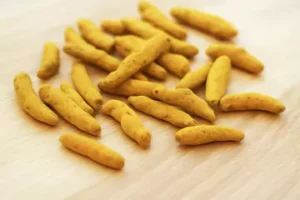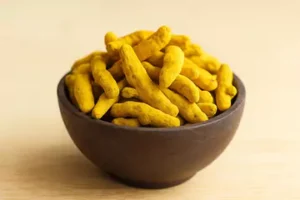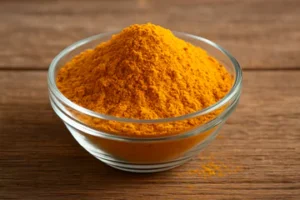Turmeric
Introduction
Turmeric (Curcuma longa) is a perennial herbaceous plant from the ginger family (Zingiberaceae), native to South Asia, particularly India. It is also known as the “golden spice” and is a vibrant yellow-orange root celebrated for its earthy flavor, natural coloring properties, potent health benefits, and cosmetics. Rich in curcumin, a powerful antioxidant and anti-inflammatory compound, turmeric is a cornerstone in both culinary and industrial applications. Our high-quality turmeric is sourced from trusted growers, ensuring purity and consistency for a wide range of uses.




Grades
Turmeric is graded based on quality, curcumin content, physical appearance, and intended use. Grading standards vary by country, but India’s Agmark certification and international standards like those of the Food and Agriculture Organization (FAO) provide common frameworks. Key grades include
Grading Factors:
- Curcumin Content: Higher curcumin levels indicate better quality for medicinal and industrial use.
- Color and Aroma: Bright, uniform color and strong aroma are preferred.
- Moisture Content: Should be below 10-12% to prevent spoilage.
- Foreign Matter: Low levels of impurities (e.g., dirt, stones) are critical for high grades.
- Processing: Hand-processed or polished turmeric fetches higher grades than unpolished.
Alleppey Finger Turmeric:
Erode Turmeric:
Sangli Turmeric:
Rajapore/Bulb and Finger Turmeric:
Madras Turmeric:
Organic Turmeric:
Powdered Turmeric:
Applications
Culinary Uses
Adds flavor, color, and aroma to dishes, especially in Indian, Southeast Asian, and Middle Eastern cuisines. Natural yellow-orange colorant (E100) for food coloring. It also has natural antimicrobial properties that extend shelf life.
Medicinal Uses
Curcumin reduces inflammation and is used in treating arthritis, joint pain, and inflammatory conditions. It is antioxidant in nature. Stimulates bile production, aiding digestion and relieving bloating, etc.
Cosmetics and Skincare
Used in face masks and creams for its antioxidant and anti-inflammatory properties, reducing dark spots and acne scars. It may also help in reducing wrinkles and improving skin elasticity. It is also used in soaps, cleansers, shampoos, and oils.
Industrial and Other Applications
Used in natural dye for fabrics, especially in traditional and eco-friendly textiles. Curcumin extracts are used in drug formulations and clinical research. It is also added to poultry and livestock feed for its antimicrobial and growth-promoting properties.
Emerging Applications
It has a growing demand for turmeric-based supplements and functional foods. Curcumin is studied for applications in wound healing, drug delivery, and tissue engineering. Research explores turmeric-based biodegradable films due to their antimicrobial properties.
